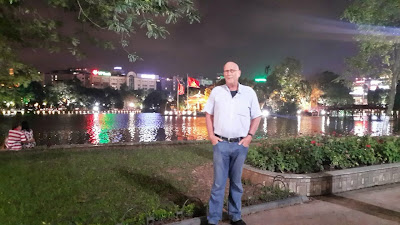Em ỏi… very likely the first words in Vietnamese one hears upon landing. The
curl on top of the "o" makes the sound veer towards "eu", but not too much. When I first
heard it and had understood that it was to call someone's attention, I thought
it was an informal way of doing so. Something like Hey you! But it is not, not informal, that is. It is the proper way
to address a man or woman younger than oneself. An older woman is addressed as Chi ỏi
and an older man as Anh ỏi. At my
age I don't have to memorise those two as age-wise I'm in the top five percent
of the population.
 |
| Hoan Kiem lake area at night |
 |
Old town 1 and 2
|
 The old town is a beautifully chaotic treasure of
old houses and gnarled trees, shops and eateries spilling out on the sidewalks,
motorcycles, scooters, cars, blaring horns and people, especially people. Fairly
small, the old town consists of some 36 streets only. Originally, specialised merchants
and trades were concentrated in a particular street. To some extent that can
still be observed although in a watered down form.
The old town is a beautifully chaotic treasure of
old houses and gnarled trees, shops and eateries spilling out on the sidewalks,
motorcycles, scooters, cars, blaring horns and people, especially people. Fairly
small, the old town consists of some 36 streets only. Originally, specialised merchants
and trades were concentrated in a particular street. To some extent that can
still be observed although in a watered down form.
From the number of eateries and the number
of customers one could easily conclude that one half of the population is serving
food to the other half. And what lovely food it is.
My favourites follow below:
Phở, the ubiquitous noodle soup with a rich, clear broth made
from a long boiling of different meats.
 Bún chả is a dish of grilled pork and noodle, which is
thought to have originated from Hanoi. Bun cha is served with grilled fatty
pork over a plate of white rice noodle and lots of green herbs with a side dish
of dipping sauce.
Bún chả is a dish of grilled pork and noodle, which is
thought to have originated from Hanoi. Bun cha is served with grilled fatty
pork over a plate of white rice noodle and lots of green herbs with a side dish
of dipping sauce.
Bánh cuốn is made from a thin, wide sheet of steamed fermented rice
batter filled with seasoned ground pork, minced wood ear mushrooms. The dipping sauce is
called nurac cham.
 |
| Bánh cuốn |
Bánh my, a term for a type of bread that is derived from the French baguette. Typical fillings are roast pork belly, pork sausage, pork liver pâté, fried egg, to which is added fresh cucumber slices, cilantro, sliced chilies, spicy chili sauce and mayonnaise.
 Banh xeo, a flat pancake made of rice
flour with turmeric and filled with shrimp, fatty pork, sliced onions, and button
mushrooms. It is eaten with lettuce and various local herbs and dipped in nurac cham. Rice papers can be used as wrappers for the banh
xeo and the accompanying vegetables.
Banh xeo, a flat pancake made of rice
flour with turmeric and filled with shrimp, fatty pork, sliced onions, and button
mushrooms. It is eaten with lettuce and various local herbs and dipped in nurac cham. Rice papers can be used as wrappers for the banh
xeo and the accompanying vegetables. Nem cuon, fresh spring rolls, and nem ran, crispy deep fried spring rolls.
Lẩu is a Vietnamese rendition
of steam boat with assorted vegetables, meats, seafood, and spicy herbs.
In my personal opinion, the best place to enjoy the full variety of Vietnamese cuisine is Quan An Ngon. In its four restaurants in Hanoi more than 300 local and street food dishes will give you an unforgettable experience.
Quan
An Ngon, addresses in Hanoi:
1. 18 Phan Boi Chau
2. 34 Phan Ding Phung
3. R4-B2 Vincom Royal City
4. 25T2 Trung Hoa Nhan Chinh


No comments:
Post a Comment